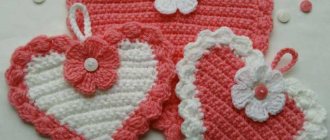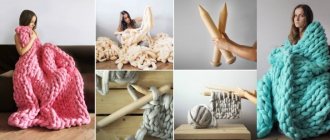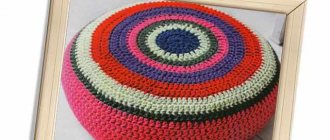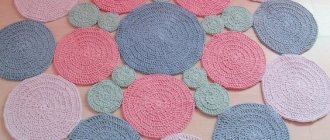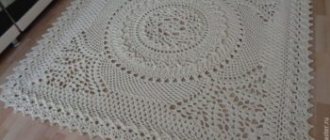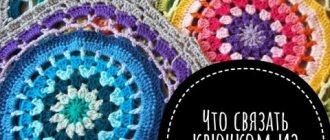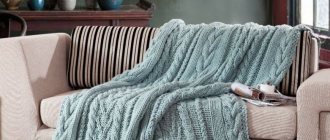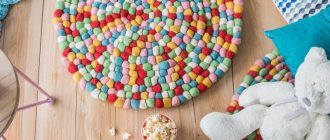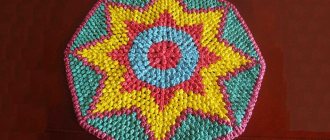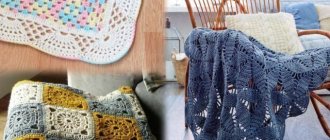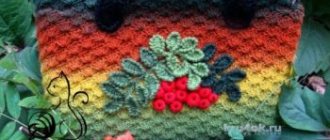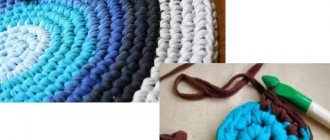Crocheted rugs will perfectly complement the interior of your apartment or house; the main thing here is to choose the right color scheme and model.
Can you crochet? Publish your work on kru4ok.ru
There is a misconception that grandmothers knit floor coverings from leftover yarn. With the advent of bright knitted yarn and beautiful polyethylene threads, a new fashion for knitted carpets began. Some of them look very expensive and stylish; even designers often use them in the interior.
What types of crocheted rugs are there?
- One-piece fabric, they are knitted in a circle, starting from the center or rectangular from the edge.
- From motives. To create a rug, you first knit individual elements of any shape (circles, diamonds, squares, triangles) from different yarns and then join them together.
- Made using the fillet technique. First, a base mesh is created, and only then the pile is added; for this purpose, “grass” or any other yarn is usually used.
- Knitted from ordinary linen cord of any shape.
- Synthetic mats for which use garbage or regular plastic bags on strips. How to make yarn from bags.
- Rugs made from knitted yarn, which is sold in handicraft stores. They turn out bright and beautiful. And if buying a lot of knitting yarn is expensive for you, then make it yourself.
- Crocheted rugs from old things. Many people advise taking knitted items or synthetic tights, but in fact, old cotton sheets that are already worn out are also suitable for rugs. These rugs have one drawback - they are not so bright, because... Worn items first lose their bright colors.
How to make rugs non-slip
In Ikea, in the flooring department, they sell STOP anti-slip mesh. The mesh is slightly rubberized. It needs to be cut to a size slightly smaller than the rug itself and laid under it. Don't glue it, the mesh won't go anywhere. Wash the mat separately from the mesh. Size 67.5 x 200 cm, price 190 rubles.
Create!
Try making knitted beauty yourself. We will tell you how to crochet both regular and unique rugs with diagrams and descriptions. Before starting work, you need to decide on the color scheme and choose a model that is organically suitable for your home or country interior.
For inspiration, look through photos of similar items on the Internet. Many of them are simply amazingly beautiful. We will show you what knitted rugs can be like and teach you how to knit models that are popular today, simple and beautiful.
It is not always necessary to have extensive experience and craftsmanship to create a knitted masterpiece. There are patterns that even a beginner can do, but the grace and beauty of the knitted product will be undeniable.
Knitting techniques
Home carpets knitted from yarn can be in the form of a continuous fabric of any shape with different knitting algorithms. For example, rectangular ones are knitted in straight rows, like on knitting needles. And the round ones start from the central loop, then knit in the round.
Knitted rugs made using the fillet technique are based on a base mesh, to which a pile of yarn, such as grass, is added. And uniform in style, separately knitted fragments in the form of any shapes are combined into a magnificent canvas of “motifs”.
We will show beginners step by step how to create a rug of different shapes from yarn with your own hands.
Mesh based products
Buy a regular repair mesh and prepare material from scraps of fabric. The optimal size of the shreds is 2 by 10. Making a carpet.
The mesh is a good helper in creating a rug from old and outdated T-shirts.
- We cut out the desired shape of the future work from the grid.
- The center of the product is the beginning of work. We pass the scrap from the bottom of the mesh to the top so that you can tie a knot.
- We perform this manipulation in each cell.
They step back 1 cm from the edge and begin to fasten scraps of fabric measuring 2*12 cm into the cells.
It’s easy and simple to make such a rug without a hook or special tools from old T-shirts with your own hands.
The shreds are brought in from the bottom of the mesh, pulling them up using a hook.
As a result, you will have a cozy shaggy rug.
Round rug
Most versatile for home use. Looks great in any interior. Made from yarn of different textures and thicknesses. It can be elegant, openwork knitted or solid, tightly knitted. Openwork and “airy” - for covering the dressing table. Voluminous, with a continuous large knit and knitted “cones” - for a nursery or living room, it holds heat well.
To create a round fabric from yarn, you need to make the first three air loops, connect the first loop to the last. Then knit a row of six single crochets. In each next row, add new loops evenly, increasing the length of the circular row.
Note!
Patterns for knitting overalls for a newborn: step-by-step master class
- How to crochet a mouse and a rat: video master class on crocheting the 2020 symbol
How to knit a warm hat with ears for a newborn boy and girl - video tutorials with patterns, instructions for beginners
In the form of a scarf
Crocheting rugs in the form of a scarf from rags can be done in 2 options:
- longitudinal,
- transverse
The difference between these methods is that when knitting longitudinally, you must immediately set the desired length, since it will not be possible to increase it later. With cross knitting this possibility exists. The same applies to the width of the product. It can be changed in the longitudinal direction, but not in the transverse direction.
Since the production of rectangular rugs involves straight and reverse rows, it is recommended to choose double-sided patterns for them, that is, so that they look the same on the front and back sides.
If knitting is carried out using the most common method, single crochets, then in order to avoid compactions between the rows, with each subsequent knitting, the working thread should be grabbed not under the two arcs of the lower loop, but only at the back one. Thus, smooth horizontal or transverse stripes (depending on the direction of knitting) are formed on the front and back sides, created by the remaining front arcs.
Rectangular rugs with square motifs
You can also create a beautiful floor rug using numerous multi-colored elements or fragments that differ in the structure of the material used.
Their knitting pattern can be either circular rows or straight or reverse. This depends on the thickness of the yarn used. For thinner source material, openwork patterns will be acceptable. Motifs from straight and reverse rows are better suited to dense raw materials. The size of the fragments is determined individually and depends on the required parameters of the finished product.
The coupling of motifs with each other can also be done in two ways: when knitting the outermost row and after making a complete set of parts. The connection of separately connected motifs is done by crocheting or sewing with a needle and thread.
Oval rug
Harmonious for geometrically elongated rooms. Before knitting it, divide the width of the future product in half and subtract it from the length, find the length of the initial chain. For example, if we plan to make a rug measuring 40 cm by 100 cm, then the desired length is 80 cm.
Remember that the cast-on chain will stretch by about 30-40% when knitting.
Next, knit in the round according to the pattern, with gradual addition of loops on the semicircular sides.
A beautiful oval rug can be made from store-bought knitted yarn or from yarn made from discarded knitted clothing.
The first and last loops must be discreetly secured with a thin thread, and to increase strength they must be glued or sewn to a dense base.
The popular model “Miracle of May” is an oval rug made on the basis of three magnificent Patricia Kristoffersen napkins. Stylish and elegant, it fascinates with its beauty and grandeur, good in any color and interior. A video master class on napkins from Patricia Kristoffersen is easy to find on the Internet.
Note!
How to crochet a beautiful scarf: video master class on creating unusual, beautiful, simple scarves for boys, girls, men and women
How to knit a hat with a lapel using knitting needles or an elastic band: step-by-step instructions for beginners
How to crochet a winter hat: 95 photos of new models of warm, fashionable, original knitted hats with a lapel and a beautiful pattern
How to make your own yarn
Knitted strips are cut from any old, unnecessary things:
- T-shirts, T-shirts;
- stockings, tights, socks;
- dresses, jumpers;
- knitted skirts, pants.
To start making yarn, all unnecessary places are cut off from the knitted product - armholes, turns, decor, etc. The remaining part is cut in a spiral, in a strip, with a width of one and a half to two cm. When winding the tape into a ball, it will spontaneously curl into a rope.
Not only knitwear can be used for work. Rugs for the bathroom, toilet, hallway, where a large amount of dirt and dust is “worn around,” are made from polypropylene “yarn” cut from colored bags. The latter can be new or used. There is also colored polypropylene store-bought twine - it is sold in skeins of 50-100 meters or more.
Rectangular crochet rug
It is laconic, its placement at home or in the country will add uniqueness to the home. Convenient as a floor runner in a country-style room or in a nursery. It is extremely easy to knit; even a beginner in needlework can handle it. The basic model is done in single crochets.
We make a chain of air loops the length of the width of the future product. Then we knit a row. Turn it over. We knit the next row in the same way as the previous one. Turn it over again. Repeat until the desired length is achieved.
For decoration, after completing the main fabric, we make tassels from the same yarn. A rectangular carpet made from square motifs is also quite accessible for beginning craftswomen.
Lush rug made of pompoms
An unusually soft, warm and cozy rug will highlight almost any interior, making it cozy and truly homely.
We will need:
- yarn (60% wool, 40% polyacrylic, 65 meters per 50 grams), 4 (7) skeins of beige, 3 (6) brown, 4 (8) light green, 4 (7) green, 4 (8) blue, 4 (7) dark blue, 3 (6) gray;
- we work with crochet number 7;
- felted loden (100% wool) width about 145 cm, dark gray or gray-brown color;
- threads for sewing in color;
- bias binding 3.2 (5) meters long.
The dimensions of the finished product will be 50 x 110 cm (72 x 160 cm)
Pompon
We make a ring of threads, leaving a free tip of about 15 cm, with the help of which we will later tighten our knitting.
We tie the ring 1 cr. R. With. without n., then we knit 4 times: * 3 unfinished s. s n. together (= 1 pompom), 1 s. without n.*, 1 pompom and close in the 1st s. without n. using ss. We cut the working thread, pull it through and sew it up. Using the end of the thread, we pull the knitting into a tight pom-pom, leaving the thread loose.
Important! You can change the sequence of coloring pages as you wish. One skein should yield approximately 26-27 pompoms.
Pattern
Scheme of work
The number of threads we suggested should be enough for approximately 88 (176) beige, 80 (160) brown, 106 (212) light green, 86 (172) green, 98 (196) blue, 92 (184) dark blue, 78 (156) gray pompoms.
We cut out the part from the loden according to the drawing, edge the sections with bias tape.
According to the pattern, we place an inner rectangle on the pieces, turn the edges inside out, iron the loden and turn it back again.
Assembly
We sew the buds onto the inner rectangle of the part in a random order: thread the remaining tip of the thread into a needle, stick it from top to bottom into the loden, pull the pompom tightly, then make 2-3 small seams and cut off the thread, leaving the tip about 3 cm.
Having sewn all the pom-poms, we turn the edges of the part inside out again and sew them together with a mattress stitch.
Square rug
So seemingly simple, but in the hands of a creative craftswoman it turns into a designer model. The square will fit harmoniously into a bathroom, glassed-in loggia or hallway. This is done in one of two ways:
- The first is similar to knitting a rectangular rug, but in compliance with the new proportions characteristic of a square: the length is equal to the width.
- The second method is using the granny square technique. We cast on eight chain stitches of the initial chain. We connect it with a half-column into a ring. We knit a row, knitting three double crochets in each corner loop. And so on in every row.
Octagonal mat
A very original model. The basis of knitting is “granny square”, but we add loops not in four corner loops, but in eight.
Note!
- How to knit a beanie hat correctly with knitting needles: video master classes, patterns, knitting patterns for fashionable models
Light and beautiful crochet shawl: photos of chic openwork scarves with simple patterns
- Turban hat with knitting needles: how to knit a turban with your own hands, patterns, video master class with step-by-step instructions
Flower
Attractive and airy, the knitted flower is quite complex to make. Only experienced needlewomen can cope with it, since each loop must be made strictly according to the pattern. Skipping at least one of them will ruin the entire drawing.
However, there is an option to make a “flower” in a simple way. We knit five identical circles with double crochets. Then we connect them as follows: we bend each circle on both sides so that a flower with five petals is formed. We sew the “petals” into a “flower”. We decorate the middle with a button or a knitted small circle.
Where to find inspiration
Any creativity is a means of self-expression, transferring your thoughts and dreams into reality. And no matter what you do: knitting, embroidery, drawing or something else, the most important thing is not to drive yourself into narrow frameworks that limit your aspirations and give free rein to your unconventional thinking. Can you do this without inspiration? We doubt it very much. So where to look for this inspiration and enthusiasm to enjoy the process. Let's try to figure it out with you.
- surround yourself with positive thoughts, enjoy the little things and keep those rosy dreams in your head.
- but throw negative thoughts out of your head, not sparing a single one of them. You definitely won't need them.
- Don’t pay attention to negative feedback, but listen to constructive criticism - it will help you develop and move on.
- If it dawns on you at the most inopportune moment, do not lose the thought, be sure to write it down so as not to forget and return to it when it is convenient.
- spend more time with your children. Children's spontaneity teaches us to see the little things in simple things and enjoy these very little things.
- Fatigue is an executioner for creativity, so rest often.
- read or watch information that can evoke emotions in you.
- surround yourself with pleasant music, atmosphere, delicious tea or sweets.
Now we offer you to look at photographs of knitted rugs and video instructions.
Knitted rug in the interior
Will add comfort and grace. For the bedroom - soft, calm colors. In the living room - bright, catchy. Pleasant to the touch textured carpets will find their application in the hallway. Rectangular ones will decorate the interior in an industrial style.
In light colors and round shape - for a room in the Provence style. Soft, colorful, with a fairytale motif, but at the same time environmentally friendly, safe and easy to clean - a rug for the nursery. It can be in the shape of a pencil, an animal, a favorite character, or your child's hobby item, such as a guitar or palette.
It is very easy to create a knitted rug in the shape of an animal: just knit simple figures in the form of elementary geometric shapes and assemble everything into a single composition.
For example, a “bear” rug looks like this: the muzzle is a simple gray circle, the ears are two white-gray semicircles, the nose is a white circle and a black triangle, the cheeks are two pink circles.
Shape, product size
An original carpet, made independently, can be made in any possible shape:
- round, oval;
- rectangular, square;
- U-shaped or crescent-shaped;
- in the shape of a star, snowflake;
- like a flower with petals.
Knitted items for a children's bedroom are made in the form of bunnies, cats, fish, bears, penguins, houses, Christmas trees, “Smeshariki”, etc. It all depends on the imagination of the parents and the kids themselves.
The approximate yarn consumption for an item measuring one square meter is 4-5 skeins of yarn, with an average knitting density.
How to choose a hook
Each craftswoman has her own priority type of hook; she chooses it at her own discretion: aluminum, plastic, steel (metal), wood, bone or a combination. However, the thickness of this tool is selected in accordance with the thickness of the yarn used for knitting and the desired knitting density.
When choosing, pay attention to how the hook feels in your hand, whether it will create tension in your fingers during prolonged use. Aluminum ones are most in demand by knitters because of their lightness, strength and availability.
Preparing yarn
Before you start knitting a rug from a variety of T-shirts and knitted rags of different colors with your own hands, you need to prepare the yarn.
Attention! The denser the fabric, the narrower you cut the ribbons for work.
Let's look at the step-by-step process of preparing yarn:
- wash and dry things well;
- cut them into even strips of equal width (about 1.5 -2 cm);
- stretch the ribbons a little so they curl into yarn;
- sew the strips together;
- Carefully roll the stitched ribbons into balls (make sure that they do not twist and have uniform tension).
It will be great if the balls turn out to be multi-colored.
The width of the strips depends on the density of the material. The thinner it is, the wider the cut strips.
Note! Knitwear for work can be cut in two ways: in a circle and in a spiral.
Mat material
Classic material - thick yarn from camel, sheep, any other wool, ribbon yarn. In accordance with its thickness, hooks are selected to work with numbers from five to eight. For durability and preservation of appearance, the best material is synthetic yarn, acrylic. Lovers of eco-friendly materials will prefer yarn made from natural cotton. It is pleasant to the touch, but does not hold heat well.
Knitting carpets from cord
Cord carpets are very textured. They add charm to the interior. Two types of cord are used in this work: cotton and polyester. Carpets made from all-natural cotton cord are more environmentally friendly. They turn out to be heavy, due to this they lie stably on the floor.
Rugs made of polyester cord are popular due to the practicality of their material and its hypoallergenicity. They are easy to clean and do not lose their shape and color even with prolonged use. It is better to choose a simpler scheme for them.
Carpets made from knitted yarn
With a skillful approach, they turn out to be original, with their own individuality. You can buy knitting yarn at the store or make it yourself. To do this, you need to cut old knitted items into strips and knit them into a single thread. Knit according to any pattern you like, suitable for thick yarn.
Carpet made from old things
The material can be leftover homemade yarn, synthetic tights, old bed linen, rope, strips of polyethylene from garbage bags. When crocheting circles on the floor from rags, you often get quite interesting and original products. They serve perfectly in the country or in a summer house. When knitting, try not to be too colorful to make the rug look stylish.
Floor rug made of round motifs
One of the interesting solutions for making floor mats is various combinations of round fragments. They can be done:
- from the same material in structure, but different in color range;
- from fabrics of different composition and color;
- from several types of patterns.
The motifs can be connected to each other both when knitting the outermost row of each fragment, and after they are completely knitted. It depends on whether there is a preliminary layout of the elements or whether it is drawn up during the knitting process, how many and what sizes the parts are prepared.
Exotic crochet Japanese rugs
Although Japanese rugs with their unique pattern look complex, the technique for making them is simple: hollow rings are knitted, which are then connected to each other. The lightest model consists of four rings filled with a fabric of double crochets. Another version of the Japanese rug: we make a knitted ring, a chain of hollow rings connected by a standard weave is sewn to it. A Japanese rug will add ethnic motifs to the interior. The carpet configuration can be changed.
It is difficult to imagine all the variety of knitted rugs. Give free rein to your creative imagination - crochet a rug yourself exactly the way you want it, best suited to the design of your home. An exclusive decorative interior element will bring comfort, coziness and warmth to your home. Don't be afraid that what you knit will look old-fashioned.
We recommend choosing the exact color of the yarn, this will add modernity to knitted interior items. The color of the materials used, in contrast with the interior color scheme, will enliven the room and add a bright personality to it.
However, try to avoid excessive variegation and the melange effect, and maintain clear boundaries between the colors of the yarn used. Apply a smooth transition from one color to another. This will give a good effect. Get inspired and start implementing your “knitted masterpiece”.
Color scheme, style
Homemade rugs are appropriate in every room and in almost any interior style:
- loft - crocheted products will fit well into such an interior. The preferred color scheme is brown-gray, beige-reddish, any wood shades;
- modern - plain rugs of simple shape are recommended. If there are several of them in one room, it is permissible to make one bright and accent;
- hi-tech - the main colors here are gray, blue, silver. Items made from textiles with lurex are perfect;
- country - checkered options, knitted from many individual squares and rectangles. Coloristic solution – black-red, gray-burgundy, etc.;
- retro - products cut from knitwear or jeans made using the patchwork technique are suitable here;
- boho - all items are as bright and colorful as possible. Primary colors – burgundy, velvet green, yellow-orange, deep blue, copper, etc.;
- Japanese - round, square rugs in neutral, mostly light colors are scattered everywhere here, replacing chairs.
Photo examples of crocheting rugs
Please repost
0
